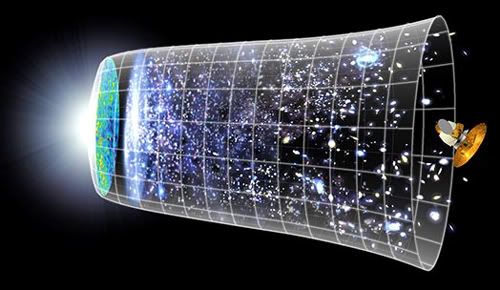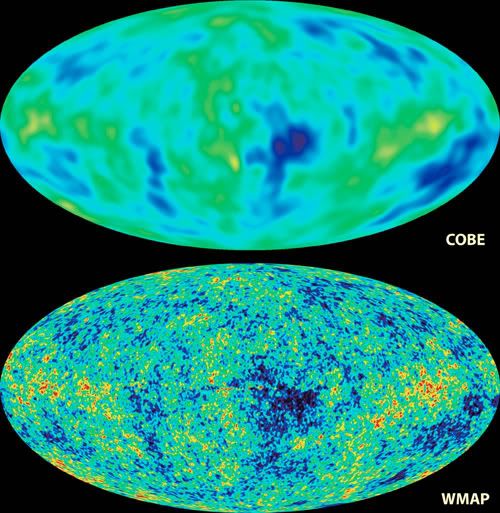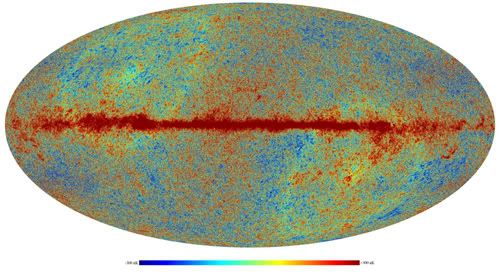
pendragon
Shared on Tue, 04/08/2008 - 18:24(COBE) Satellite helps to Explore Big Bang Theory.


Countless observations have shown that our Universe has been expanding for billions of years. If we could play the cosmic movie backwards, at some point in the distant past all the matter and energy we see today must have been crammed together in a tiny region of unimaginably high density and temperature. Cosmologists call that moment the Big Bang.
In the mid-1960s, Bell Labs astronomers Arno Penzias and Robert Wilson serendipitously discovered that microwaves are coming from all directions in the sky with equal intensity. The Big Bang model for the beginning of the Universe actually predicted that we should see an afterglow radiation that fills the Universe. Penzias' and Wilson's discovery of this afterglow, now known as the cosmic microwave background, was a turning point in cosmology since it convinced most scientists to embrace the Big Bang model for the origin of our Universe.
To study the cosmic microwave background in more detail, scientists launched NASA's Cosmic Background Explorer (COBE) satellite in 1989. Led by John Mather of NASA's Goddard Space Flight Center, the COBE team found a perfect match between the measured spectrum of the background and the spectrum predicted by the Big Bang theory. The exquisite correlation between theory and observation—a rarity in science—offered powerful support to the idea that our Universe did in fact originate in a Big Bang.
Another COBE group, led by George Smoot, discovered slight temperature fluctuations embedded in this afterglow that point back to slight density differences in the infant Universe. These fluctuations were the primordial seeds that evolved into all the large-scale structure we see today as gravity turned these small deviations into clusters of galaxies and the humongous voids between clusters. Mather and Smoot shared the 2006 Nobel Prize in Physics for their groundbreaking measurements.
Scientists working with data from NASA's Wilkinson Microwave Anisotropy Probe (WMAP) refined these results in 2003 and again in 2006 by resolving the temperature fluctuations down to smaller angular scales. Working with theory and other astronomical data, the WMAP results pin down the age of our Universe (13.7 billion years), the era of first starlight (about 400 million years after the Big Bang), and the cosmic recipe (74% dark energy, 22% dark matter, and 4% familiar "atomic" matter). WMAP's precise measurements are beautifully consistent with the theory that the infant universe experienced a brief moment of hyperexpansion—inflation.
What is WMAP?
It is the Wilkinson Microwave Anisotropy Probe that NASA, the U.S. Space Agency, launched into space in summer 2001 in order to collect high quality data about the
Universe. NASA has recently published a series of superb photos generated from this probe.

Where is WMAP?
WMAP sits at what is called a saddle point -- the so-called L2 Lagrange Point. Here the gravitational pull of the Sun and the Earth just balance each other, but it is a precarious balance. It is about 1.5 million km beyond the Earth's orbit. This is an ideal pont from which to view deep space, free from interference from the Sun, Earth and Moon.
What is the instrument?
The WMAP probe weighs about 800 kg. The instrument is shaded from the Sun, Earth and Moon by the spacecraft itself. This allows data to be taken with lower thermal disturbances. It is a collection of microwave radiometers which are cooled to avoid any thermal disturbances. It takes data in 5 frequency bands in the microwave region.
Also, it is a differential experiment; it does not measure the absolute temperature but rather the temperature difference between any two points in the sky. It does this by having back-to-back telescopes looking at opposite sides of the sky. The light received by these telescopes is fed into symmetric microwave receivers which then compute the difference in temperature between the two measurements. This allows for very accurate measurements.

What does MAP probe?
It is now believed that the Universe originated about 15 billion years ago and has been continually expanding since then. This is called the Big Bang theory of the origin of the Universe.
The WMAP mission studies objects in the Universe that are very far away. We know that light travels at constant velocity in vacuum. So the light reaching us today from distant stars was emitted by the star very long ago. So studying these far away objects is like studying the very early Universe.
As the Universe expands, the light that was originally present is now stretched out to a longer wavelength and mostly appears as microwave (very large wavelength, low-frequency) light. See the figure. This light (called Cosmic Microwave Background Radiation or CMBR) now fills the entire Universe and is like a tell-tale fingerprint of the Early Universe.
The word microwave means that the light waves that are emitted in this region are not visible to the naked eye. They have very long wavelength, of the order of cm and are just like radio waves. In fact, the earliest measurement of cosmic microwave background was observed as excess noise in radio receivers.
The radiation is uniformly distributed in the sky with a mean temperature of about 3 degrees K (or 270 degrees below 0 C). However, there are very small fluctuations about the mean value. These fluctuations in this light were first measured in 1992 by COBE, another NASA space probe. Now the WMAP probe measures tiny fluctuations in this CMBR that differ from the mean value by only a millionth of a degree.
As explained above, WMAP creates a picture of the microwave radiation using temperature differences measured from opposite directions. This is called anisotropy. Hence it is called a microwave anisotropy probe (MAP). The radiation it studies was released approximately 380,000 years after the birth of the Universe. That's like seeing the picture of an 80 year old man when he was 1-day old !
As importantly, the WMAP is capable of resolving angular distances of less than a millionth of a degree. So it can probe really tiny bits of the Universe and so give results to high accuracy.
What are the WMAP results?
If we make a temperature map of the Earth for the month of July we get a pattern of data that can be displayed in a colourful way to help us understand the results. For instance, it will be easy to imagine that the central latitudes are colour-coded red for "warm" and the poles are coloured blue for "cold". If we turn our gaze upward and make a picture of the whole sky, we can display that data in a similar oval format for easy examination. WMAP measures the fluctuations in the temperature of microwaves coming from the entire Universe. These fluctuations correspond to the seeds that grow into Galaxies. By studying the patterns of fluctuations, scientists can answer many questions such as the age and geometry of the Universe.
WMAP results.
The new data support and strengthen the Big Bang theory (and the theory of Inflation which is part of the theory of the evolution of the Universe). It also fixes the age of the Universe very precisely, to 13.7 billion years, within one percent. This means that the Universe could be 13.8 billion years old but not 14.0 !!
A surprising result from WMAP is that the first stars were born about 200 million years after the Big Bang. This is much earlier than was earlier thought.
Dark matter and dark energy
WMAP shows that the matter of which we (and the solar system and nearby starts) are made is only a small portion of the Universe, just 4% in fact. Another 23% is an exotic type of matter called ``cold dark matter'' that neither generates heat nor light, but is massive. Finally 73% is an even more exotic ``dark energy'' which has no mass as well !! Scientists are all working to decide what could be the form and nature of this dark energy that permeates the Universe. Whatever it may be, it has one sure consequence for the geometry of the Universe: we explain this below.
The geometry of the Universe.
The amount of matter (and dark matter) and dark energy in the Universe play a crucial role in determining the geometry of space. If the density of matter and energy in the Universe is less than some value, called the critical density, the space is open and the Universe will keep expanding out for ever. Also space will have negative curvature, that is, it will be like the surface of a saddle. If the density is greater than the critical density, then space is closed and eventually the Universe will begin to stop expanding, and begin to contract. Such a Universe will have a positive curvature, like the surface of a sphere.
The matter content will determine whether the Universe ends in a cold death or a Big Crunch. The theory of Inflation is an extension of the Big Bang theory and predicts that the density of the Universe is very close to the critical density. In this case, the Universe is flat and not curved. The WMAP observations show that this is indeed so. The Universe will expand for ever. However the origin and meaning of the dark energy remain a facinating mystery. There are still many questions left to be answered about our Universe.
Big Bang Cosmology
This model postulates that the Universe originated about 12 to 14 billion years ago. A billion is a thousand million; the age of the Earth (and Sun) is roughly 5 billion years. At that time, the Universe was only a few millimetres across and very different from what it is today. First of all, it was very dense (compressed matter) and hot. From that time, it has been continually expanding and cooling, just as gas expands and cools.
In fact, gas that is not confined in a vessel eventually diffuses over all available space. Similarly, the Universe has been continually expanding and cooling, so that the average temperature of the Cosmos today is about 3 Kelvin (or 270 degrees below zero C), very cold indeed!
Only as the Universe cooled could protons and electrons come together to form hydrogen. Until then, the cosmic radiation was continually scattered by free electrons. Neutral hydrogen is transparent and so once hydrogen was formed, the cosmic radiation could travel freely through the Universe. This radiation has a spectrum that is determined by its last scattering with electrons, so measuring this spectrum can also confirm the Big Bang model.
Soon deuterium and helium formed and the other elements as well. Gravity brought hydrogen atoms together and they got compressed into stars. Stars formed galaxies, clusters, and other cosmic objects. Super-heavy stars exploded as supernovae and scattered heavy elements including iron into the Universe. We humans are literally composed of stardust.
The amount of helium in the Universe and in fact the density of ordinary matter in the Universe are predictions of the Big Bang theory and have been tested by WMAP.
- pendragon's blog
- Log in or register to post comments


Comments
Submitted by Anonymous (not verified) on Thu, 10/20/2011 - 22:20
Submitted by Deman267 on Wed, 04/09/2008 - 10:09
Submitted by pendragon on Wed, 04/09/2008 - 14:46
Submitted by Anonymous (not verified) on Tue, 09/27/2011 - 02:23
Submitted by Anonymous (not verified) on Tue, 11/29/2011 - 19:15
Submitted by KingBayman on Tue, 04/08/2008 - 18:42
Submitted by pendragon on Tue, 04/08/2008 - 19:10